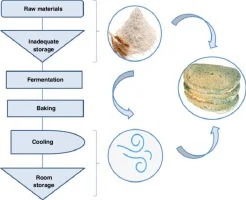Explain how a slice
of bread after few days decomposes due to growth of fungi?
 |
Explain how a slice
of bread after few days decomposes due to growth of fungi. |
When a slice of bread is left exposed to the environment for a few days, it provides an ideal environment for the growth of fungi. Fungi are microorganisms that thrive in warm, moist conditions and are well-adapted to decomposing organic matter, such as bread. Here's how the decomposition process occurs due to the growth of fungi:
1. Moisture Absorption: Bread contains a certain amount of
moisture, and when exposed to the air, it can absorb additional moisture from
the environment. This increased moisture content creates an environment
conducive to microbial growth.
2. Spore Germination: Fungi reproduce through tiny
reproductive structures called spores. These spores are present in the air and
can settle on the surface of the bread. When conditions are favorable, the
spores germinate, giving rise to fungal hyphae.
3. Hyphal Growth: Fungal hyphae are thread-like
structures that spread and penetrate the bread, breaking down its complex
carbohydrates and proteins into simpler compounds. This process releases
nutrients that the fungi can use as a food source.
4. Mycelium Formation: As the hyphae continue to grow and
branch out within the bread, they form a network of fine, white filaments
called mycelium. The mycelium is the main body of the fungus and serves as the
site for nutrient absorption.
5. Visible Mold Growth: As the mycelium grows and consumes nutrients,
it becomes visible on the surface of the bread as patches of mold. Mold
commonly appears as fuzzy, green, black, or white growths, depending on the
species of fungus involved.
6. Release of Spores: As the mold matures, it produces
reproductive structures called sporangia or conidia, which contain spores.
These spores are released into the surrounding environment and can be carried
by air currents to colonize new substrates, continuing the reproductive cycle
of the fungi.
7. Decomposition of Bread: The growth
of fungi and the enzymatic activity of the mycelium break down the bread's
organic matter into simpler compounds. The bread becomes softer, loses its
texture, and may develop an unpleasant odor and taste.
8. Secondary Decomposers: As
the bread decomposes, it attracts other microorganisms, such as bacteria and
other fungi, which contribute to the breakdown of the bread's organic matter.
The process of bread decomposition due to fungal growth
is a natural part of the ecosystem's nutrient recycling. However, from a food
safety perspective, consuming moldy bread is not recommended, as some molds can
produce toxins that may be harmful to human health. Therefore, it is essential
to store bread in a dry, cool place and consume it before mold growth becomes
visible.
